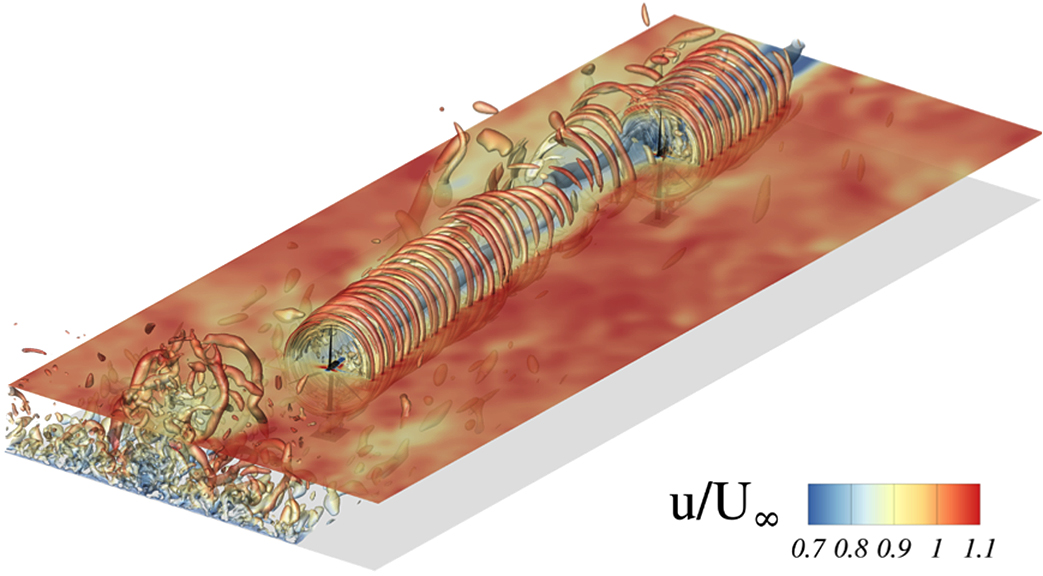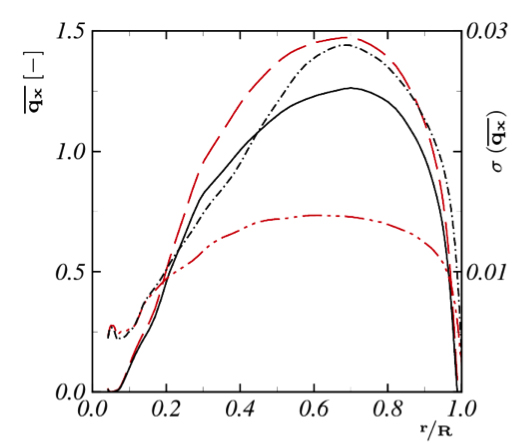ENVIRONMENT AND ENERGY
Simulation of Unsteady Loads and Wakes of Wind Turbines at Turbulent Atmospheric Inflow Conditions
Principal Investigator:
Thorsten Lutz
Affiliation:
Institute of Aerodynamics and Gas Dynamics, University of Stuttgart (Germany)
Local Project ID:
WEAloads
HPC Platform used:
Hermit and Hornet of HLRS
Date published:
In order to develop economic, efficient, and reliable wind turbines, the knowledge of the mechanisms that evoke transient aerodynamic loads effecting blades, tower, and the nacelle is essential. Using high performance computing technologies, researchers of the University of Stuttgart used high-fidelity Computational Fluid Dynamics (CFD) methods to accurately predict these unsteady loads. Particular interest was paid on the interaction of wind turbine and atmospheric boundary layer.
The demand to reduce production costs in the generation of electric energy from wind is a major objective in energy policy. For this purposes wind turbines require to be placed in regions of relatively higher wind speeds. These can be found for example offshore where the turbines are embedded in large wind farms. To develop reliable turbines which require little maintenance it is important to accurately predict the aerodynamic loads on the blades. Particular interest is put on the fluctuations of these loads which lead to enhanced fatigue loading of the entire turbine. These load fluctuations result from rapid changes in the local angle of attack due to atmospheric turbulence, which particularly is produced in wind turbine wakes.
In the framework of load prediction methods, the role of Computational Fluid Dynamics (CFD) is becoming increasingly important as high-performance computing capacities are steadily increasing. These render it possible to simulate the unsteady behavior of entire wind turbines operating in their environment. In contrast to the widely used engineering tools, which are based on blade element momentum theory, solving the Navier-Stokes equations and directly representing all relevant wind turbine components within CFD poses the most accurate approach to calculate unsteady aerodynamic effects as for example found in the heart of a wind farm
For the simulations, a hybrid RANS/LES (Reynolds-Averaged Navier–Stokes/Large-Eddy Simulation) approach is used, where the incoming atmospheric inflow is propagated in LES mode and the flow in the vicinity of the turbine is treated by classical URANS (Unsteady Reynolds-Averaged Navier-Stokes Simulation). The simulations have been performed using the code FLOWer developed by the German Aerospace Center (DLR) on the CRAY HPC systems “Hermit” and “Hornet” of the High Performance Computing Center Stuttgart (HLRS). A typical job with 100 million grid points ran on 2048 cores for 170,000 iterations. Hence, the total computational effort of a single job was around 400,000 CPU hours.
A general idea of the flow field can be obtained from Figure 1. The turbines, shown in black, are placed in the original distance as in the German offshore research wind farm “Alpha Ventus” for half wake conditions. This means that the wake of the upstream turbine hits only one side of the rotor area of the downstream turbine. The vortices are visualized with the Λ2criterion, whereas the contour denotes the flow velocity relative to the mean wind speed. The turbulent inflow is coming from left to right. As can be seen, the velocity is decreased behind the upstream turbine. The tip vortices interact with the atmospheric inflow and start breaking down approximately three diameters behind the upstream turbine. However, some vortices still arrive at the downstream turbine. The wake behind the shadowed turbine interacts with the velocity deficit induced by the upstream turbine resulting in an asymmetric velocity distribution there.

Figure 1: Vortex structures and velocity distribution of the flow around two interacting wind turbines. Vortices are visualized with the Λ2 criterion, contours are the relative velocity.
Copyright: IAG, University of StuttgartThe load distribution as well as the load fluctuations change when focusing on the downstream turbine. As shown in Figure 2 the mean blade loads decreases which goes along with a reduction in the power output of the shadowed turbine by approximately 15% compared to the upstream turbine. However, as the loads only decrease if the blade is inside the wake, standard deviation becomes significantly higher which results in enhanced fatigue.

Figure 2: Time averaged normalized axial line load over the blade and its standard deviation. Turbine 1 (red), Turbine 2 (black).
Copyright: IAG, University of StuttgartKey Facts of a typical job:
- 2048 cores
- 100 mill. grid points
- 3 TB data
- 170,000 iterations
References:
Weihing, Pascal, et al. "CFD Performance Analyses of Wind Turbines Operating in Complex Environments." High Performance Computing in Science and Engineering ‘14. Springer International Publishing, 2015. 403-415.
Weihing, P., et al. "CFD simulations on interference effects between offshore wind turbines." Journal of Physics: Conference Series. Vol. 524. No. 1. IOP Publishing, 2014.
Scientific Contact:
Pascal Weihing
Institute of Aerodynamics and Gas Dynamics
University of Stuttgart
Pfaffenwaldring 21, D-70569 Stuttgart (Germany)
e-mail: weihing [at] iag.uni-stuttgart.de